Ostriches are large, flightless birds native to Africa. They are the largest living species of bird and can reach up to 9 feet in height and weigh up to 320 pounds, making this list of ostrich predators so intriguing.
Ostriches have long legs that allow them to run extremely fast, reaching speeds of up to 43 mph. They mainly feed on vegetation such as grasses, seeds, fruits, leaves, and roots, but they will also consume insects and small animals if available.
Ostriches are highly reproductive animals, and the female can lay up to 15 eggs in a single clutch. The incubation period for an ostrich egg is 42 days, after which the babies hatch. Ostrich chicks are precocial, meaning they are born with their eyes open and able to walk within minutes of hatching.
They stay with their parents for around two years before becoming independent adults. On average, an adult ostrich’s lifespan is between 40-45 years, but some have been known to live as long as 60 or 70 years in captivity!
What Eats Ostriches?
- Cheetah
- Lion
- Leopard
- Spotted Hyena
- Crocodiles
- Black Backed Jackal
- Vulture (eggs)
- Baboon (eggs)
- Meerkat (eggs)
Ostrich Predators: Cheetah
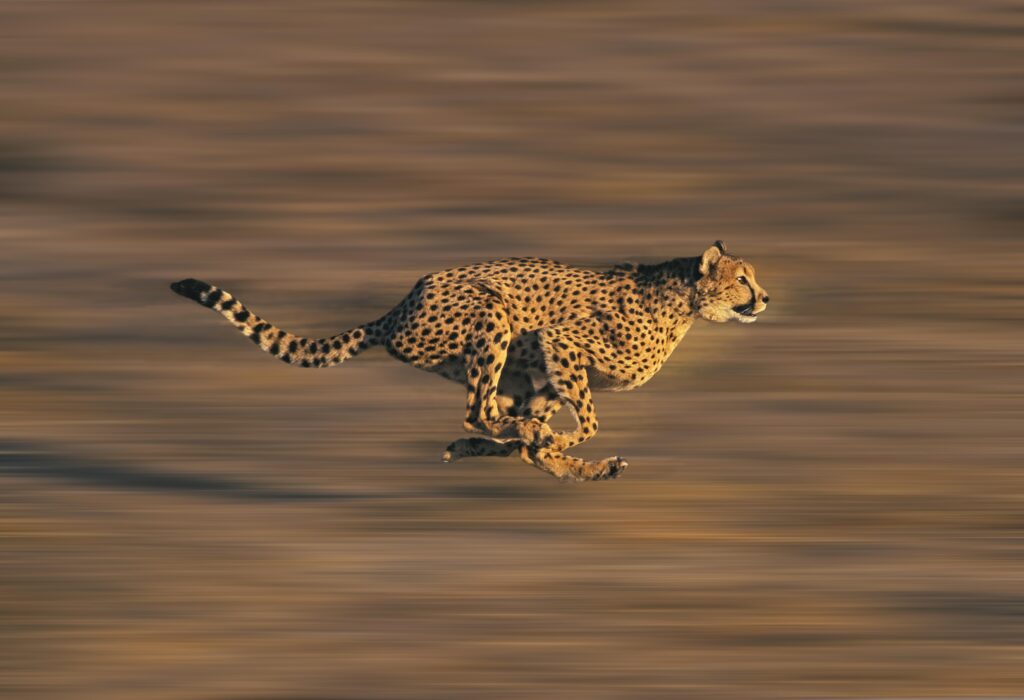
The cheetah uses its speed to chase down prey, and occasionally to avoid becoming prey itself.
©iStock.com/slowmotiongli
Cheetahs are the fastest land mammals and can reach speeds up to 70 mph. They typically prefer hunting small animals like hares, antelopes, gazelles, and birds. Their primary food source is medium-sized antelopes such as impalas or Thomson’s gazelles.
When it comes to hunting ostriches, cheetahs usually wait for them in tall grassy areas where they can catch their prey by surprise. Once caught off guard, the cheetah will pursue its target until it tires out from running away so much. Then the cheetah will close in for the kill, using its sharp claws and teeth before dragging its prey back home or eating it on site.
Ostrich Predators: Lion
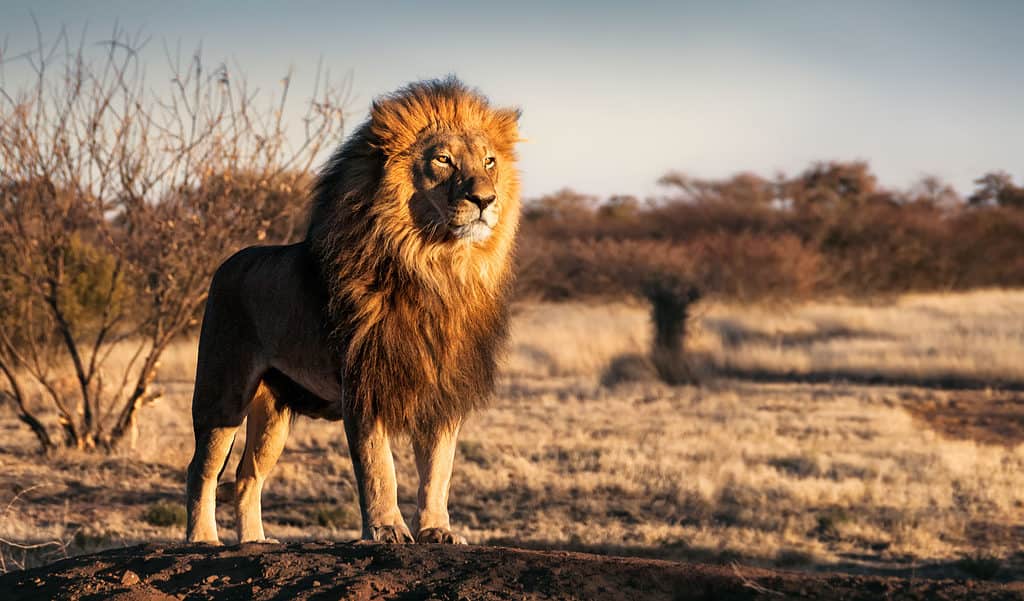
Lions kill their prey by breaking its neck, or by means of suffocation.
©2021 Photography/Shutterstock.com
Lions are predators and the apex predator in their habitat. They have a wide range of prey, but their primary food source is usually ungulates such as wildebeest, gazelle, zebra, buffalo, and hartebeest.
Lions hunt by stalking their prey before chasing after it and killing it with a bite to the neck or the back of the head. When hunting ostriches, they use similar strategies, stalking them from behind cover until they are close enough to pounce if necessary. Ostriches are very fast runners, so lions may employ tactics like group hunting or ambush to catch them more easily.
Ostrich Predators: Leopard

The Leopard is a solitary and nocturnal animal that hunts both on the ground and in the trees.
©Rudi Hulshof/Shutterstock.com
Leopards are a large cat species native to Africa, Asia, and the Arabian Peninsula. They have powerful limbs and teeth that enable them to take down larger prey such as antelopes, wild pigs, and even crocodiles. Leopards typically hunt at night, stalking their prey until they can get close enough for an ambush.
Their primary food source is usually medium-sized ungulates like antelope, but they also eat smaller mammals such as hares or rodents when available. When it comes to hunting ostriches, leopards will usually wait in hiding until they spot one, and then launch into a high-speed chase.
Since these birds can reach speeds of up to 43 miles per hour, it’s not an easy task! Once within range, the leopard will use its powerful jaws and claws to grab hold of the bird before killing it with a bite to the neck or head.
Ostrich Predators: Spotted Hyena
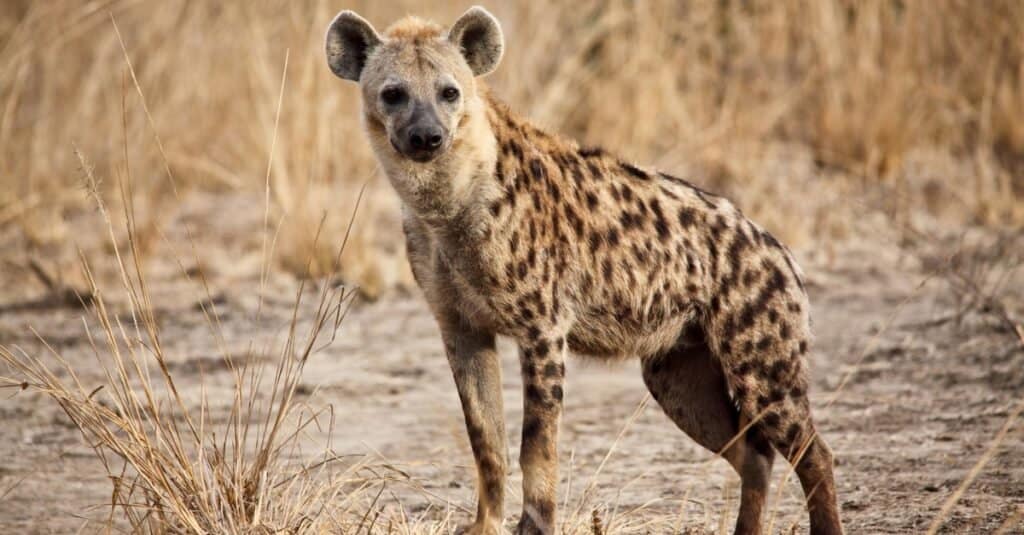
Hyenas usually chase their prey to exhaustion.
©gualtiero boffi/Shutterstock.com
Spotted hyenas (Crocuta crocuta) are large, carnivorous mammals native to Africa. They have a unique appearance with spotted coats and long legs. They are capable of running at speeds of up to 37 miles per hour, and they live in social groups called clans.
Their primary food source is other animals, such as antelopes, zebras, wildebeests, hares, birds, and rodents. However, when food is scarce or not available, they may scavenge for carrion or hunt small domestic livestock like sheep or goats.
When hunting for ostriches, spotted hyenas will often work together as a team. One member of the pack will usually distract the ostrich while another sneaks around from behind and grabs it by its wings before dragging it down to the ground, where the rest of the pack can attack it more easily.
Ostrich Predators: Crocodiles

Crocodiles can turn and attack with lightning speed.
©Audrey Snider-Bell/Shutterstock.com
Crocodiles are major predators of ostriches in Africa. They inhabit almost all African waterbodies, from small streams and ponds to large lakes and rivers. Their primary food source is fish, but they also hunt for larger prey such as wildebeest, zebras, antelopes, bushbuck, and even ostrich eggs if available.
Crocodiles will patiently wait for an opportunity before attacking an unsuspecting ostrich. When the time comes, they use their powerful jaws to latch onto the bird’s legs or feet until it succumbs to exhaustion. The crocodile then drags its catch underwater, where it drowns before being consumed by the reptilian predator.
Ostrich Predators: Black-Backed Jackal

Black-backed jackals are known for their cunning and daring.
©Sharon Haeger/Shutterstock.com
The black-backed jackal is a medium-sized canid found throughout much of Africa and parts of the Middle East. Their coat is typically reddish brown or yellowish-grey with a distinctive black saddle on their back.
They are mainly scavengers, feeding on carrion and small mammals such as rodents, hares, and hyraxes. However, they will also prey upon larger animals, such as antelopes, when they have the opportunity to do so. When it comes to hunting an ostrich, black-backed jackals use their superior speed and agility to outmaneuver them in open terrain where ostriches cannot take cover in dense vegetation.
Jackals will observe from a distance before moving in quickly once an opportune moment presents itself, usually when the bird has been distracted by another sound or movement nearby. The jackal then uses its large canine teeth to bite into the legs of its prey until it becomes still enough for capture or death — whichever comes first!
Ostrich Predators: Vulture

A vulture’s stomach acid is so strong that it kills most bacteria and viruses, including rabies.
©Rob Hainer/Shutterstock.com
Vultures are scavenging birds found throughout Africa. They primarily feed on the carcasses of dead animals, though they will also eat eggs and hatchlings in some cases. Vultures can spot an ostrich egg from a great distance due to their keen eyesight, which allows them to see the bright colors and glossy surface of the eggs from miles away.
When they find a nest with eggs, they will often tear through it with their sharp beaks until they reach the reward inside. Vultures may even use team tactics when hunting for food. One vulture will distract an adult ostrich while others sneak in and take its eggs away, unnoticed!
Ostrich Predators: Baboon
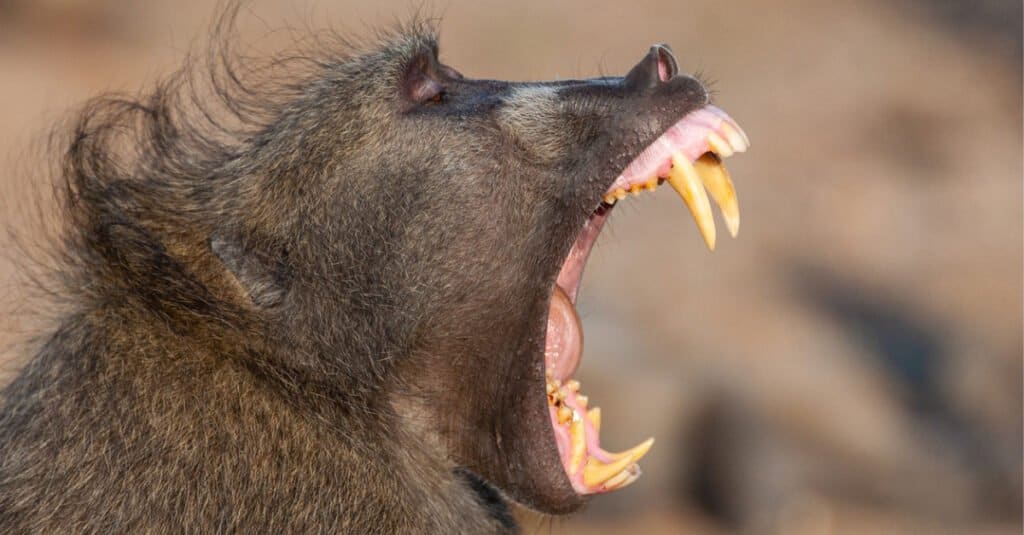
Baboons are known to kill and eat small animals.
©iStock.com/RudiHulshof
Baboons are a species of large primates that live in Africa. There are five different types of baboons, all of which inhabit different areas and have slightly different diets and behaviors.
The primary food source for baboons is mostly plant matter such as leaves, grasses, fruits, and roots. However, they will also eat insects and eggs if the opportunity arises. Baboons are known to raid crops in agricultural zones, so they can be considered pests by some farmers.
When it comes to hunting for ostrich eggs specifically, baboons usually locate them either by sight or smell. When an egg is laid on the ground, it emits a distinctive odor that attracts predators such as hyenas and jackals, as well as most primate species, including baboons. Once located, the baboon will use a rock to break open the hard shell before consuming the contents inside.
Ostrich Predators: Meerkat
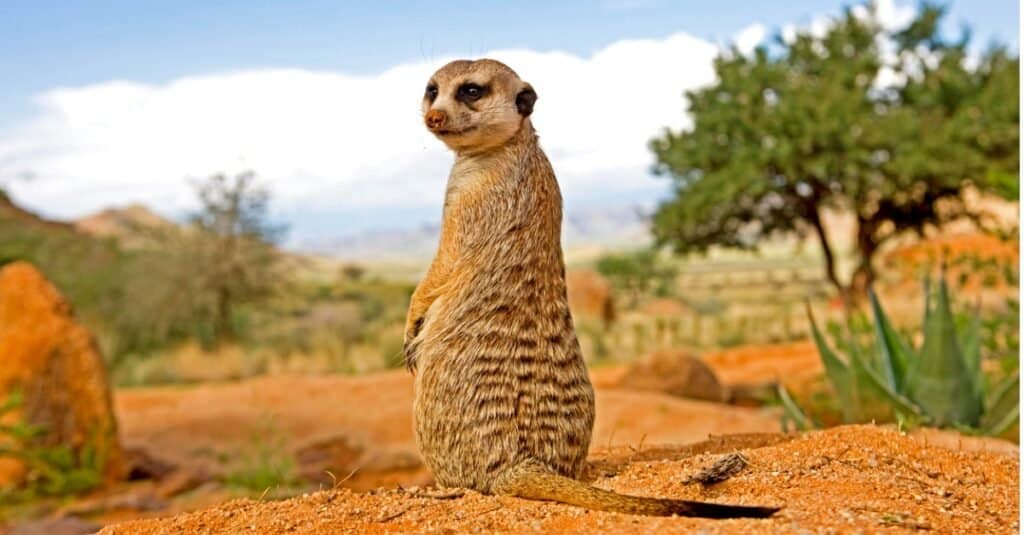
Meerkats have been said to be the most murderous mammal, as they’re the most likely to kill their own kind.
©iStock.com/slowmotiongli
Meerkats are small mammals native to parts of Africa. They live in large groups and work together to find food. Their primary source of food is insects, but they will also eat small reptiles, eggs, and plants. Meerkats hunt for their prey by standing on their hind legs and scanning the horizon with sharp eyesight.
The answer to the question of whether meerkats eat ostrich eggs is yes. Meerkats have been known to hunt in groups and raid nests for eggs, which they then consume. Ostrich eggs are a rich source of protein, making them an attractive target for meerkats looking for food. They may also be attracted to the eggs due to their size: ostrich eggs can weigh up to three pounds!
How Do Ostriches Get Away From Predators?
Ostriches are one of the fastest animals on two feet and can run at speeds up to 43 miles per hour. This impressive speed is often their primary defense against predators, allowing them to outrun most threats that may come their way. Ostriches also have keen eyesight, enabling them to spot potential danger from far away distances.
In addition, ostriches use a number of other strategies for self-defense when they feel threatened or if their chicks or eggs are in danger. These include kicking with powerful legs and using wings as shields.
In some situations, an ostrich will even team up with other members of its flock in order to protect itself from harm — a strategy known as “mobbing,” which involves making loud noises and running around together as a group in confusion and disarray so that any predator would become confused and less likely to attack (at least until it becomes too overwhelmed).
The photo featured at the top of this post is © John Michael Vosloo/Shutterstock.com
Thank you for reading! Have some feedback for us? Contact the AZ Animals editorial team.






